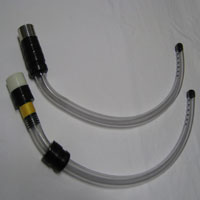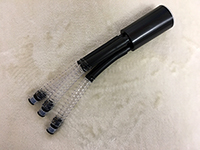

What is moisture control?
Do I need it in my bagpipes?
by Ian Lyons
In some form, Moisture Control has been used in bagpipes for hundreds of years. Starting off with very simple devices to catch condensation and moisture in the blowpipe stock and then the use of simple tubes inside the bag.
With the introduction of synthetic pipe bags in the 1980's, in particular those with opening access to inside the bag, there is now a whole industry around moisture control for bagpipes.
What is moisture control?
The escence of moisture control for bagpipes is to catch moisture, in the form of either condensation or saliva, and prevent it from reaching your drone reeds or pipe chanter reed before it has an effect on how the reeds perform and operate. Moisture control within the bagpipes is a balancing act! Cane reeds need a small amount of moisture to perform at their optimum level whereas synthetic drone reeds essentially perform at their best when 100% dry. Moisture control also aleviates the amount of moisture getting into the bagpipe bag and allows you to collect, regulate and dispose of excess moisture using these devices.
With more and more emphasis on hygene and control of bacteria and build-up inside the bagpipes, moisture control systems are becoming essential.
Below is a photo of a simple split stock tube water trap (left) and also a full drones moisture control system (right).
A simple tube trap allows you to capture moisture within the tube and then tip it out periodically or when neccessary. The tube can also be extracted and cleaned between plays.
Full moisture control systems have canisters which are filled with different types of granules or absorbant rocks that either absorb, catch or delay moisture. The canisters can easily be disconnected and the granules or rocks can either be dried out in an oven or microwave or allowed to dry naturally.
Do I need moisture control in my bagpipes?
The most important thing to note is, every person is different. We all expel different amounts of moisture when we play the bagpipes and we all interact with our bagpipes differently. So, what works for someone else may not work for you. Listen to advice but assess your own requirements and act on them to suit yourself.
The easiest way to assess the need for moisture control for your bagpipes is to monitor the moisture levels. Every bagpipe player creates moisture within their bagpipes, to some extent.
For beginners, moisture control may not be needed in the initial stages of learning to play. Beginner pipers generally don't playing for long enough periods of time for moisture to become an issue. But as you progress to being able to play several tunes over maybe a 15 minute period or more continuously, then you'll see that you require some form of moisture control.
The test is! After you play, simply take out the chanter and look closely around the reed seat to see if there are any beads of moisture. Also take out your drones and look closely at the tongue and body of the drone reeds to see if there is any moisture beaded there. If the answer is yes, then you need moisture control to stop this, before it happens.
The simple fact is, if the bagpipes are colder than your breath, then the warm air of your breath coming into contact with the cooler surface will create condensation. Exactly like breathing on a pane of glass! In the initial few minutes of playing the bagpipes, the internal bore of the blowpipe and then further into the bagpipes will experience condensation. Where the moisture goes to, after that, depends on the type of moisture control fitted. The goal is to "control" the amount of moisture at this stage. As the bagpipes warm up to similar levels as your body and/or breath, and the external temperature, the levels of condensation reduce but then the levels of saliva being blown into the bagpipes will increase, depending on how wet a blower you are. If you are using a tube trap you'll notice that the first tip-out is primarily condensation, runny water, and after that it changes to a more saliva consistency.
Moisture control will only hold back the flood gates for an allotted amount of time. So, the type of playing that you do will also come into consideration. If you just play a few tunes for your own pleasure, once a week, then you'll need a simple moisture control solution compared to a piper who is practicing most days and also attending rigourous band practice sessions.
If you are just playing occasionally you may only need a simple tube trap or could also opt for a full moisture control syatem. If you are playing very regularly, for intense sessions, you will need full moisture control capabilities. If you have a pipe bag fitted that has zip access, then you can use pretty much every available moisture control option or brand. You do not have to use the accompanying brand moisture control as the brand of your pipe bag. If you are using a tied-on animal skin pipe bag, then you are limited to a tube trap, but this can be altered or enhanced to suit.
How to use moisture control
The aim of moisture control inside the bag is to "control" the levels of moisture in your bagpipes.
If you are using a simple tube trap, you will need to tip out the moisture periodically during your playing sessions and then remove the tube at the end of each session to clean and dry it before the next session.
If you are using a full moisture control system, at the end of each session it's important to open the zip on your pipe bag and remove the canister. Each brand of canister is different, so you then need to dry out the granules or rocks, as per the manufacturers instructions.
Moisture control within the bagpipes requires continuous monitoring. The levels of moisture within your bagpipes continually changes depending on how regularly you are playing and the environments in which you play. It will also change from season to season.
Always be aware of your moisture control as it will save you when you need it most!
Pipe Majors! Remember, what is good for you might not be good for all the pipers in your band. Assses everyone's moisture control individually to get the best results.
Any Questions:- sales@lyonsbagpipes.com
Website Created and Managed by Lyons Bagpipes & Highland Supplies©